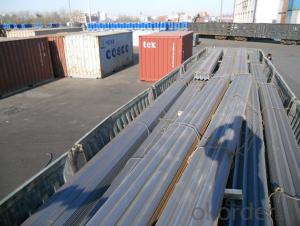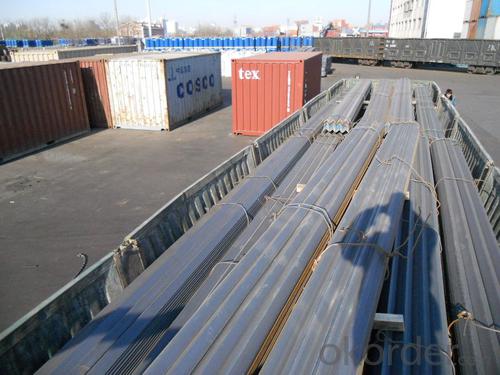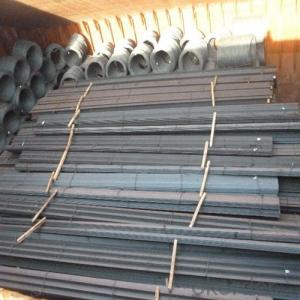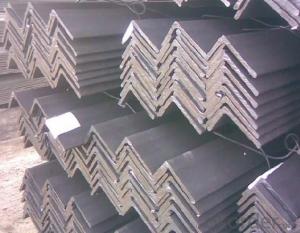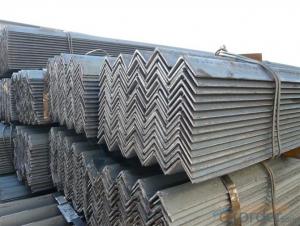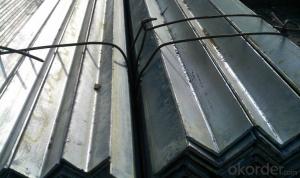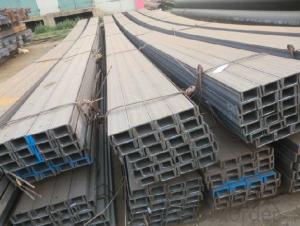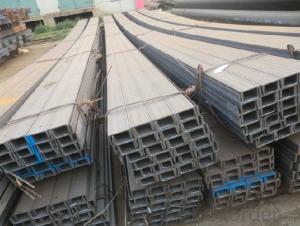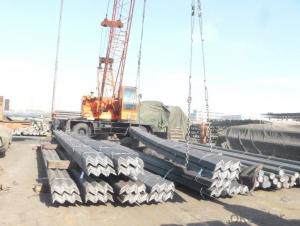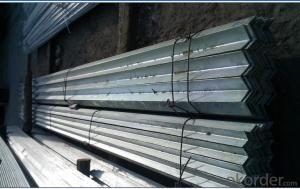hot angle and gb
- Loading Port:
- China Main Port
- Payment Terms:
- TT OR LC
- Min Order Qty:
- -
- Supply Capability:
- -
OKorder Service Pledge
OKorder Financial Service
You Might Also Like
Angle Details:
| Minimum Order Quantity: | | Unit: | m.t. | Loading Port: | |
| Supply Ability: | | Payment Terms: | | Package: | wire rod packing |
Product Description:
Product Description:
Specifications of Angle Steel
1. Invoicing on theoretical weight or actual weight as customer request
2. Length: 6m, 9m, 12m as following table
3. Sizes
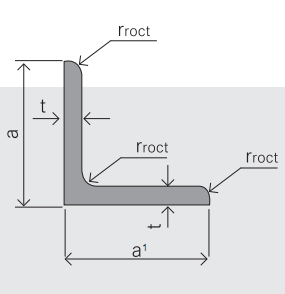
Sizes: 25mm-250mm | ||
a*t | ||
25*2.5-4.0 | 70*6.0-9.0 | 130*9.0-15 |
30*2.5-6.6 | 75*6.0-9.0 | 140*10-14 |
36*3.0-5.0 | 80*5.0-10 | 150*10-20 |
38*2.3-6.0 | 90*7.0-10 | 160*10-16 |
40*3.0-5.0 | 100*6.0-12 | 175*12-15 |
45*4.0-6.0 | 110*8.0-10 | 180*12-18 |
50*4.0-6.0 | 120*6.0-15 | 200*14-25 |
60*4.0-8.0 | 125*8.0-14 | 250*25 |
5. Payment terms:
1).100% irrevocable L/C at sight.
2).30% T/T prepaid and the balance against the copy of B/L.
3).30% T/T prepaid and the balance against L/C
6.Material details:
Alloy No | Grade | Element (%) | | ||||
C | Mn | S | P | Si | | ||
| | |||||||
|
|
|
|
|
|
| |
Q235 | B | 0.12—0.20 | 0.3—0.7 | ≤0.045 | ≤0.045 | ≤0.3 | |
|
|
|
|
|
|
| |
Alloy No | Grade | Yielding strength point( Mpa) | | ||||
Thickness (mm) | | ||||||
≤16 | >16--40 | >40--60 | >60--100 | | |||
≥ | | ||||||
|
|
|
|
|
| | |
Q235 | B | 235 | 225 | 215 | 205 | | |
Alloy No | Grade | Tensile strength (Mpa) | Elongation after fracture (%) | | |||
Thickness (mm) | | ||||||
| ≤16 | >16--40 | >40--60 | >60--100 | | ||
≥ | | ||||||
|
|
|
|
|
|
| |
Q235 | B | 375--500 | 26 | 25 | 24 | 23 | |
Usage & Applications of Angle Steel
According to the needs of different structures, Angle can compose to different force support component, and also can be the connections between components. It is widely used in various building structures and engineering structures such as roof beams, bridges, transmission towers, hoisting machinery and transport machinery, ships, industrial furnaces, reaction tower, container frame and warehouse etc.
Packaging & Delivery of Angle Steel
1. Packing: it is nude packed in bundles by steel wire rod
2. Bundle weight: not more than 3.5MT for bulk vessel; less than 3 MT for container load
3. Marks:
Color marking: There will be color marking on both end of the bundle for the cargo delivered by bulk vessel. That makes it easily to distinguish at the destination port.
Tag mark: there will be tag mark tied up on the bundles. The information usually including supplier logo and name, product name, made in China, shipping marks and other information request by the customer.
If loading by container the marking is not needed, but we will prepare it as customer request.
Production flow of Angle Steel
Material prepare (billet) —heat up—rough rolling—precision rolling—cooling—packing—storage and transportation
- Q: How do steel angles compare to aluminum angles in terms of strength and durability?
- Steel angles are generally stronger and more durable than aluminum angles. Steel has a higher tensile strength and yield strength, meaning it can withstand greater forces and pressures without deforming or breaking. Additionally, steel is more resistant to corrosion and can maintain its structural integrity for longer periods compared to aluminum, which is more prone to oxidation and may weaken over time. Therefore, for applications requiring high strength and long-term durability, steel angles are a preferable choice over aluminum angles.
- Q: How do steel angles compare to other structural materials?
- Steel angles are a popular choice in the construction industry due to their versatility and strength. Compared to other structural materials, such as wood or aluminum, steel angles offer several advantages. Firstly, steel angles have superior strength and load-bearing capacity. They can support heavy loads and provide structural stability, making them ideal for use in buildings, bridges, and other infrastructure projects. Steel angles also have a high resistance to bending and twisting, ensuring durability and longevity in various applications. Additionally, steel angles are highly versatile. They can be easily customized and fabricated into different shapes and sizes, allowing for precise and efficient construction. This flexibility enables designers and engineers to create complex structures and achieve specific architectural requirements. Steel angles also provide excellent fire resistance compared to materials like wood. Steel is non-combustible, meaning it does not fuel the spread of fire, making it a safer option in buildings and structures. Moreover, steel angles have a high recyclability rate, making them environmentally friendly. Steel is one of the most recycled materials in the world, and using steel angles in construction contributes to sustainable building practices and reduces the demand for new raw materials. However, it is worth mentioning that steel angles can be more expensive than some other materials, such as wood or aluminum. Additionally, steel requires proper surface treatment and corrosion protection to prevent rusting and maintain its structural integrity. Overall, steel angles offer numerous advantages over other structural materials, including superior strength, versatility, fire resistance, and recyclability. These qualities make them a preferred choice in many construction projects, where durability, efficiency, and safety are paramount.
- Q: How do steel angles perform in terms of thermal conductivity?
- Steel angles have relatively low thermal conductivity compared to other materials, meaning that they do not easily conduct heat. This property makes steel angles less prone to thermal expansion or contraction, making them suitable for various applications where temperature fluctuations are a concern.
- Q: Are there any limitations or restrictions on the use of steel angles?
- Yes, there are limitations and restrictions on the use of steel angles. These limitations can include load-bearing capacity, bending and torsional resistance, and the specific application requirements. Steel angles may not be suitable for certain structural or engineering purposes where other materials or shapes may be more appropriate. Additionally, local building codes and regulations may impose specific restrictions on the use of steel angles, such as minimum sizes, spacing, or connection requirements.
- Q: What are the different methods of corrosion protection for steel angles?
- Steel angles can be protected from corrosion through various methods, each having its own advantages and disadvantages. 1. Protective coatings are commonly used to safeguard steel angles. These coatings include paint, epoxy, and galvanization. Paint creates a barrier that prevents moisture and oxygen from reaching the steel surface. Epoxy coatings offer a more robust layer, providing enhanced corrosion protection. Galvanization involves applying a zinc layer to act as sacrificial protection, corroding before the steel. 2. Cathodic Protection utilizes an external electrical current to safeguard steel angles. By connecting the steel to a more easily corroded metal, such as zinc or magnesium, and applying direct current, the less noble metal corrodes instead of the steel. This method is beneficial in marine or underground environments. 3. Alloying can also protect steel angles from corrosion. By adding small amounts of metals like chromium or nickel to the steel composition, the resulting alloy forms a protective oxide layer on the surface, preventing further corrosion. Stainless steel is an excellent example of an alloy with high corrosion resistance. 4. Barrier Films create a physical barrier on the steel surface to prevent corrosion. This method involves applying films like polyethylene or PVC, which block moisture and oxygen from reaching the steel. It is commonly used in environments with harsh conditions or chemicals. 5. Environmental Control is another way to prevent corrosion. By controlling the environment in which the steel angles are placed, exposure to moisture, humidity, and corrosive chemicals can be minimized. Proper ventilation, regular cleaning, and maintaining a dry environment contribute to corrosion prevention. It is important to consider several factors, such as the specific application, environmental conditions, and budget constraints, to determine the most suitable corrosion protection method for steel angles. Consulting corrosion experts or engineers is recommended for a tailored approach.
- Q: What is the maximum shear force for a steel angle?
- The maximum shear force for a steel angle depends on various factors such as the material properties, size, and design specifications. To determine the maximum shear force, it is necessary to consult the relevant engineering standards, guidelines, and calculations specific to the particular steel angle being used.
- Q: What is the process of punching holes in steel angles?
- The process of punching holes in steel angles typically involves using a specialized machine called a punch press. The steel angle is securely clamped into the machine, and then a punch and die set is aligned with the desired location for the hole. The machine is then activated, and the punch is driven into the steel angle, creating a hole. This process can be repeated multiple times to create multiple holes in the steel angle, if needed.
- Q: What are the different methods for strengthening steel angles?
- There are several methods for strengthening steel angles, including heat treatment, cold working, and alloying. Heat treatment involves heating the steel to a specific temperature and then cooling it rapidly to increase its hardness and strength. Cold working, on the other hand, involves deforming the steel at room temperature to enhance its strength. Alloying is another method where additional elements are added to the steel to improve its strength and other properties.
- Q: Can steel angles be used in the construction of storage tanks?
- Steel angles have the potential to be utilized in the construction of storage tanks. These angles are frequently employed in the construction sector due to their robustness, longevity, and adaptability. When it comes to storage tanks, steel angles can serve as structural elements to provide the necessary support and stability for the tank's framework. They are commonly employed to establish the framework for the tank's walls, roof, and base, thereby ensuring the overall strength and stability of the tank. Furthermore, steel angles can also be used to reinforce corners and joints, thereby enhancing the structural integrity of the tank. In general, incorporating steel angles into the construction of storage tanks is a dependable and cost-efficient option.
- Q: How are steel angles welded or joined together?
- Steel angles are commonly welded or joined together using different welding techniques. The most common method is by using arc welding, which includes processes like shielded metal arc welding (SMAW), gas metal arc welding (GMAW), and flux-cored arc welding (FCAW). In shielded metal arc welding, an electric arc is created between a coated electrode and the steel angle, melting the metals and forming a weld joint. Gas metal arc welding utilizes a continuous wire electrode and a shielding gas, such as argon or a mixture of argon and carbon dioxide, to protect the weld from atmospheric contaminants. Flux-cored arc welding uses a hollow wire electrode with flux inside, which creates a shielding gas and slag to protect the weld. Another method for joining steel angles is by using resistance welding. This technique involves applying pressure and passing an electric current through the joint area, which generates heat and forms a weld. Resistance welding methods commonly used for steel angles include spot welding and seam welding. Additionally, steel angles can be joined together through stud welding. Stud welding involves placing a threaded or unthreaded stud against the steel angle and using an arc welding process to fuse the stud to the angle. It is important to note that the specific welding or joining method used for steel angles depends on factors such as the thickness and type of steel, the desired strength of the joint, and the application requirements.
Send your message to us
hot angle and gb
- Loading Port:
- China Main Port
- Payment Terms:
- TT OR LC
- Min Order Qty:
- -
- Supply Capability:
- -
OKorder Service Pledge
OKorder Financial Service
Similar products
Hot products
Hot Searches
Related keywords
